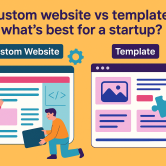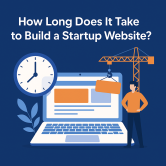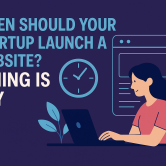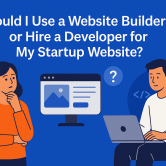How Long Does It Take to Build a Startup Website?
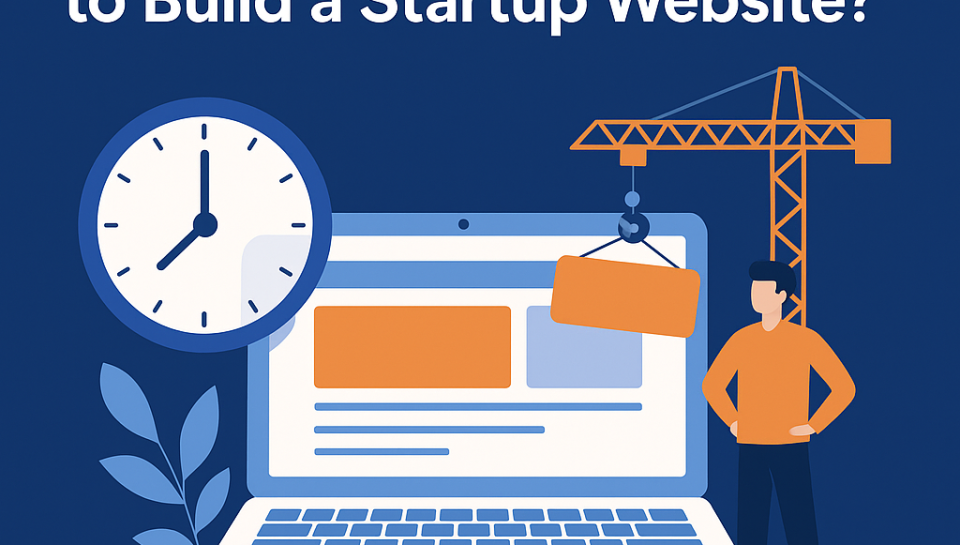
Introduction
When a startup begins its journey, one of the most common and critical questions that founders ask is: How long does it take to build a startup website? This isn’t just a curiosity—it’s a vital part of planning product launches, marketing campaigns, and funding strategies. Your website often serves as the first interaction between your business and your audience. It can either impress or repel. But timelines can vary widely, and understanding why is crucial. In this blog, we will deeply explore the timeline of building a startup website, break down every stage, and help you set realistic expectations for your business launch.
Problem: The Risk of Misjudging Timelines
Startups, by nature, operate in a fast-paced, competitive environment. Misjudging the time required to build a website can lead to missed launch dates, disappointed investors, and lost marketing momentum. Many entrepreneurs expect their website to go live in a few days or weeks, only to realize midway that design, development, testing, and optimization take longer than anticipated. On the flip side, overestimating the time can delay market entry and reduce your startup’s agility.
Understanding what affects the website development timeline—scope, budget, technology, and team capability—helps avoid costly surprises and ensures you’re not stuck in development limbo.
Solution: A Breakdown of Website Development Timelines
Let’s dissect the timeline into key phases and estimate the average duration of each. Keep in mind that these durations can fluctuate depending on whether you’re using a website builder, template, or going for full custom development.
1. Discovery and Planning (1–2 weeks)
Before any coding begins, startups must identify:
Target audience and user personas
Website goals (lead generation, brand awareness, e-commerce, etc.)
Key features and functionalities (blog, booking engine, chat support)
Competitor analysis and brand differentiation
This phase also includes creating a site map and preparing initial content drafts.
2. UI/UX Design (2–4 weeks)
Good design takes time. Designers create wireframes and high-fidelity mockups that align with your brand vision and user expectations. This stage includes:
Wireframes and low-fidelity prototypes
Visual mood boards and brand identity guidelines
Mobile-first and responsive design planning
Client feedback and iterations
For startups that prioritize unique design and user experience, investing in proper design is non-negotiable.
3. Development (3–6 weeks for MVP)
Development timelines vary drastically based on your tech stack and requirements:
Template-based WordPress sites: 1–2 weeks
Custom WordPress or Shopify builds: 2–4 weeks
Fully custom MERN-stack or headless CMS: 4–6+ weeks
Frontend and backend development happens here, including:
Homepage and core pages
Dynamic content integration (blogs, portfolios)
API integrations (email, CRMs, payment gateways)
4. Content Creation and Optimization (1–2 weeks)
SEO-optimized content is essential for startup websites. This stage includes:
Copywriting headlines and service descriptions
On-page SEO (keywords, metadata, alt tags)
Image selection and optimization
Accessibility enhancements
5. Testing and QA (1 week)
Before launch, the site must be tested for:
Browser and device compatibility
Performance and load speed
Mobile responsiveness
Functional testing (forms, payments, navigation)
Bug fixing and improvements can take 3–7 days depending on feedback rounds.
6. Launch and Post-Launch Monitoring (1 week)
Launching involves domain setup, SSL installation, server deployment, and DNS propagation. Post-launch, startups should monitor:
Traffic and user behavior
Error logs and uptime reports
Page speed and SEO indexation
Total Estimated Time: 6–12 weeks on average.
What Real Startups and Data Say
According to a report by GoodFirms, the average website takes about 2 months to complete. The range varies widely:
Basic sites: 3–4 weeks
Business websites: 6–8 weeks
Custom websites with advanced features: 10–16 weeks
A Clutch survey showed that 70% of startups initially underestimate the time and resources needed to build a functioning website. More than 50% needed to revisit their site within the first year due to incomplete features or poor performance.
Example Timeline Visual
Figure: Typical Startup Website Timeline (Weeks)
| Phase | Estimated Duration |
|---|---|
| Planning | 1–2 weeks |
| UI/UX Design | 2–4 weeks |
| Development | 3–6 weeks |
| Content & SEO | 1–2 weeks |
| Testing & QA | 1 week |
| Launch | 1 week |
| Total | 6–12 weeks |
Benefits of Planning Your Website Timeline
1. Better Investor Communication
Startups that present clear timelines during fundraising gain more credibility. Time-based milestones show that you have operational discipline.
2. Improved Product-Market Fit
With sufficient planning time, startups can conduct A/B testing, refine content messaging, and adjust design to better resonate with their audience.
3. SEO and Launch Readiness
When time is properly allocated for content and technical SEO, the site performs better on search engines from day one.
4. Lower Technical Debt
Rushed websites accumulate bugs and inefficient code. Proper timelines allow thoughtful development, saving future costs.
5. Competitive Advantage
Startups that launch polished websites earlier tend to attract early adopters faster and gain organic traction.




